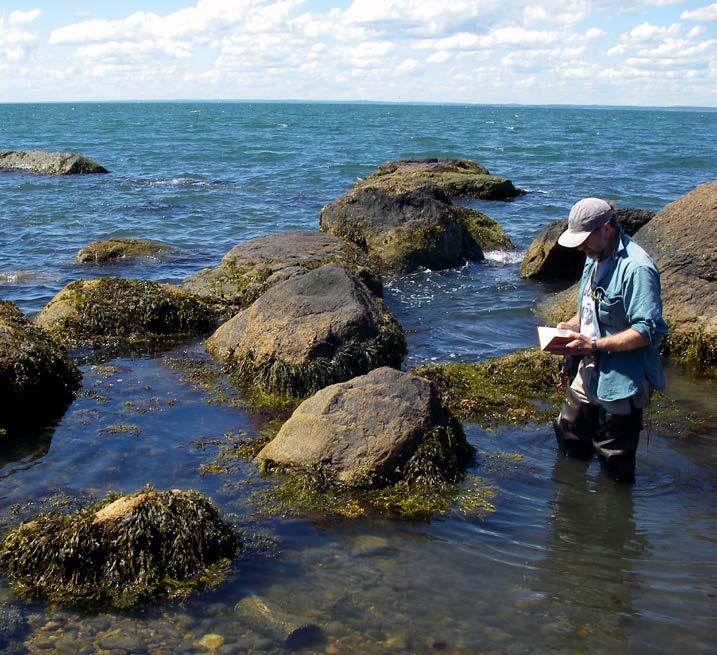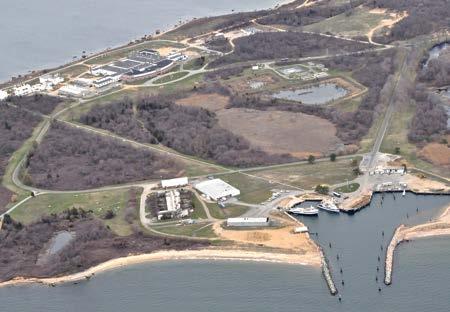
9 minute read
The Path Forward: Disposal and Beneficial Use of Plum Island
A Strategy to Achieve Our Plum Island Preserve Vision
With the help of Marstel-Day, LLC, we developed an integrated, comprehensive Plum Island Disposal and Beneficial Reuse Strategy.67 The strategy builds on the Plum Island Preserve vision and provides conveyance pathways for all of Plum Island and the Orient Point ferry parcel. This chapter is a condensed version of Marstel-Day’s full report.
The standard federal process for disposal of surplus property would provide New York and local governments the right to request (a) a Public Benefit Conveyance (PBC) for some or all of Plum Island at no cost or reduced cost for park, historic monument, conservation, or educational uses; or (b) a Negotiated Sale option for other public purposes. By contrast, under the 2009 and 2012 legislation exempting Plum Island from the standard property disposal process, the General Services Administration is on course to sell Plum Island at a Public Sale, which is the same as an auction, where the highest bidder buys the property.
The PPIC believes the State of New York is well suited to be the public agency champion for the preservation and reuse of Plum Island. The State has a rich history of leading and executing the protection of open space, including islands, and in 2016 it included acquisition of Plum Island in its New York State Open Space Conservation Plan.68 The PPIC encourages New York to continue its championing of Plum Island as an important part of its ongoing conservation plans.
Summary of Disposal Options
Conservation District PBC for Parks, Historic Monuments and/or Wildlife Conservation (one or multiple PBCs)
Negotiated Sale
Property is suitable for one or more conservation or recreationbased PBCs, noting that these would require a federal-sponsorapproved management plan and would include perpetual land use restrictions.
A Negotiated Sale is a viable option, provided the State agrees to ensure long-term protection for the site’s natural and cultural resources.
Research District PBC for Education and/or Public Health public uses (one or multiple PBCs).
Negotiated Sale
Site is suitable for PBC, noting that PBC would require 30-year use restriction, which could limit future use of this site if it were no longer viable for the originally intended PBC use.
New York State could request via Negotiated Sale for any public or private use that provides a public benefit and could use sale or rental income to support Plum Island activities.
Purpose is to preserve the integrity of this parcel and its ability to support a wide range of potential future Plum Island reuses by assuring continued ferry service between Plum Island and Long Island.
A related purpose is to prevent a private purchaser from acquiring this site and subsequently interfering with the desired reuse of Plum Island.
Role Play
In this chapter, we identify a role or roles the State of New York could play in a given scenario.
Of course this is contingent on the State wishing to play the leadership role identified in this chapter’s reuse scenarios for acquiring, conserving, and managing Plum Island, including facilitating future re-use as needed.
If the State is so willing, this chapter identifies specific strategies we think the State should consider to plan for the acquisition of the property.
The Preserve Plum Island Coalition fully understands that any decision by the State to acquire Plum Island will be based on the decision-making authority of the governor and his executive and agency staff.
With that in mind, all scenarios described here are intended to serve as inputs for consideration in that decision process.
The PPIC and its 110 member organizations, with support of the region’s elected officials, call for the Department of Homeland Security, General Services Administration, and Congress to stop the planned Public Sale of Plum Island.
DISPOSAL FRAMEWORK:
PUBLIC BENEFIT CONVEYANCES (PBC) AND NEGOTIATED SALES
To achieve the Plum Island Preserve vision, the standard federal property disposal options best suited to both zoning districts and the Orient Point parcel are one or more PBCs and/or a Negotiated Sale. Conversely, a Public Sale is least likely to result in protection of the island’s precious resources; rather, such a sale is most likely to lead to their destruction.
Public Benefit Conveyance Option. Federal law has created multiple types of PBCs that enable state and local governments to acquire property at no cost or reduced cost. The PBC process requires federal agency sponsors for each type of PBC; this, then, is a consideration that must be evaluated by the potential PBC recipient(s).
PBCs are useful disposal mechanisms where state or local governments have a clear plan for long-term, public reuse of surplus federal property. However, PBCs also require property recipients to develop a long-term plan to fund and manage parcels for the purposes allowed in the individual PBC program—and, they do not permit the future reuse of the property for other than permitted purposes for as long as the PBC restriction exists:
• Education and public health research use
= 30 years;
• Park, historic monument, and conservation use = perpetuity.
It is common for disposal of a large, diverse parcel to include multiple PBC requests that are based on different proposed uses. Each PBC parcel must have a defined recipient; multiple parties can develop a plan to cooperatively manage the parcel, however. For example, a park preserve, as envisioned for Plum Island, could include roles for entities specializing in park management, wildlife and habitat protection, and cultural/ historic preservation and events.
Negotiated Sale Option. Although a Negotiated Sale technically is a form of PBC,69 the federal government treats it very differently as a separate type of disposal. It is subject to different rules and procedures. Primary differences include:
• the buyer pays fair market value,70 per published requirement in the Federal Management Regulation,
• the sale is negotiated directly with GSA (and not with a sponsoring federal agency), and
• there are no future-use requirements or restrictions on the property.
Negotiated sales frequently are used when a proposed use does not fit into a PBC category.
The primary advantage of a Negotiated Sale is the lack of future land use restrictions. It also allows a transferee (state or local governments are the only authorized initial transferees; they can sell the property to any future parties, however) to:
• acquire title to prior to finalizing reuse plans for the property,
• do so through a non-competitive process, and
• avoid competing for and potentially paying above-market prices through a Public Sale.
The transferee is free to lease, subdivide or sell the property for any purpose to any recipient. This can be useful if there are multiple potential property re-users or tenants, e.g., research labs or commercial entities that would be interested in using portions of the property, but not in taking control of the entire parcel.
The only restriction associated with a Negotiated Sale is a three-year windfall profits provision, in which any net profits above and beyond the costs incurred to plan and redevelop the property would be recouped by GSA.
Public Benefit Conveyance Alternative. State and local officials would decide if it is more practical to:
• apply for a single PBC (e.g., for park and recreational use) for the PIC District and to manage historic and ecological resources under it, or
• apply for and manage separate PBCs for each of these uses.
APPLYING THE DISPOSAL FRAMEWORK TO THE PLUM ISLAND CONSERVATION (PIC) DISTRICT
Disposal options compatible with the Conservation District include Public Benefit Conveyances for state park, historic monument, and/or wildlife conservation use, or a Negotiated Sale.
A single PBC is administratively simpler by virtue of involving only one real estate transaction, one sponsoring agency, and one property recipient. It would be prudent for New York State Office of Parks, Recreation and Historic Preservation (NYSOPRHP) and Department of Environmental Conservation (NYSDEC) to confirm that a single PBC could accommodate all of their program requirements, however.
If multiple PBCs are contemplated, then it may make sense for the NYSOPRHP to submit both applications; an ultimate outcome of managing the park and historic monuments assets jointly would be possible. The National Park Service (NPS) approves both park and historic monument PBCs.
Negotiated Sale Alternative. A Negotiated Sale could provide another pathway to acquire Plum Island land for conservation use. Under this scenario, New York State could purchase some or all of the island at fair market value, considering the value impacts (i.e., diminution of value) resulting from the statutory, regulatory, and zoning restrictions on the future use of the property. Another government entity, such as Suffolk County, also could participate in the purchase. Upon acquisition, the transferee(s) could decide which agencies would manage the refuge areas and the historic/recreation/ public access areas. Potential guidance from U.S. Fish and Wildlife Service (USFWS) and support from private conservation organizations would enhance management outcomes.
APPLYING THE DISPOSAL FRAMEWORK TO THE PLUM ISLAND RESEARCH (PIR) DISTRICT
For the Research District, disposal options would include a PBC for education or public health, or a Negotiated Sale.
Under either scenario, lead agency and supporting agency roles would need to be defined in terms of funding and providing ferry access, utility operations, and public safety services to Plum Island after the PIADC is closed. Planning should include two potential scenarios:
• one in which the State assigns an entity other than a transferee responsibility for the PIADC complex and maintaining its support services, and
• one in which the PBC/Negotiated Sale transferees are responsible for developing a plan for managing and providing these services, either on an interim or permanent basis.
Public Benefit Conveyance Alternative. Education and public health research PBCs are limited to state and local governments and to tax-supported or nonprofit institutions. In this scenario, New York State officials would seek to:
• identify potential state education agencies, universities, or public health agencies that could request such a PBC, or
• establish a goal of receiving a letter of intent from a qualified nonprofit educational or public health research entity within the next two years to prepare to submit a PBC application by the time that the PIADC is vacated.
Negotiated Sale Alternative. With a Negotiated Sale, the State would have the option of subdividing the Research District and selling or leasing portions of it, as opportunities arose, to multiple reuse entities. Further, future land uses would not be restricted, as they would be with a PBC. The appropriate disposal option for the Research District will depend on the success of State and local officials in attracting a large-scale educational and/or public health research organization to reuse the specialized PIADC. The potential for the Department of Homeland Security to receive at least some revenue from a Negotiated Sale also could provide an incentive for Congress, DHS, and GSA to support using the standard federal property disposal process for Plum Island.
Applying The Disposal Framework To The Orient Point Parcel
The Town of Southold’s Marine III (MIII) zoning ordinance, which restricts the permitted use to providing ferry service to and from Plum Island, has not yet been applied to any particular parcel; the Preserve Plum Island Coalition supports the MIII zone being applied to the PIADC’s Orient Point ferry parcel, however. This parcel should be included in a PBC or Negotiated Sale request for Plum Island itself; the parcel is vital to support reuse of the island.

Public
Benefit Conveyance Alternative.
If the State pursues a park, wildlife preserve, or historic monument PBC for the Conservation District, it also should inquire if it can include the Orient Point ferry parcel in the PBC request. If not, it should seek to acquire the Orient Point ferry parcel through a Negotiated Sale to ensure future public access to Plum Island similar to the role that it would play for the Research District.
Negotiated Sale Alternative. If the State pursues a Negotiated Sale of the Research District, it should include the Orient Point ferry parcel to ensure future access to that parcel and preclude any other purchasers from acquiring it and thus limiting access to Plum Island.
Summary
There is growing awareness of Plum Island’s nationally significant cultural, historic, and natural resource values, and the need to protect them from being lost forever in a Public Auction to the highest bidder. Over the past year, New York State officials have become more engaged in the reuse process, and stakeholders have agreed on a coherent vision with preferred property disposal and reuse options. Stakeholders have pragmatic reuse ideas, including:
• Controlled public access to the island through a state park Federal Lands to Parks Program Public Benefit Conveyance, with technical support provided by other public and private entities to reduce park operating costs and to protect sensitive habitat.
• A Negotiated Sale to acquire the Plum Island Research District parcel or all of Plum Island, including the Orient Point ferry parcel, an option that would provide reuse flexibility and provide surplus land sale revenue to the Department of Homeland Security.
These ideas and developments demonstrate that a Public Sale is not the only practical means for GSA to dispose of Plum Island, or to obtain sale revenue on behalf of DHS/GSA

Now, New York State and local officials and conservation stakeholders are well-positioned to enter into discussions with the GSA to see if a transfer plan can be formulated, and to urge Congress to change the Public Sale language for Plum Island in pursuit of alternatives consistent with Southold’s zoning and stakeholder positions.


—NYS Assemblyman Steve in What Do You See? (Halaczinsky and Engelke 2018)

CHAPTER 4







